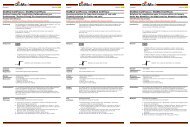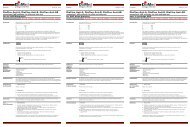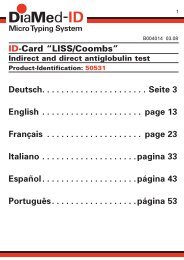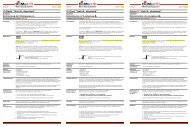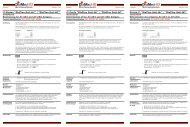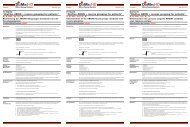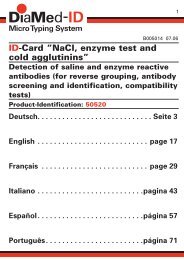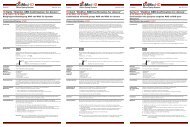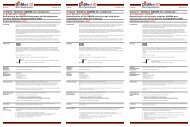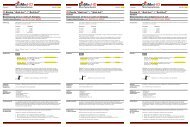“DiaClon Anti-M” und
“DiaClon Anti-M” und
“DiaClon Anti-M” und
You also want an ePaper? Increase the reach of your titles
YUMPU automatically turns print PDFs into web optimized ePapers that Google loves.
Deutsch B007011 07.07 English B007011 07.07 Français B007011 07.07<br />
ID-Karten <strong>“DiaClon</strong> <strong>Anti</strong>-<strong>M”</strong> <strong>und</strong> <strong>“DiaClon</strong> <strong>Anti</strong>-N”<br />
monoklonal<br />
Bestimmung der M (MNS1) <strong>und</strong> N (MNS2) Blutgruppen<br />
Produkt-Identifikation: DiaClon <strong>Anti</strong>-M: 212 50212 / DiaClon <strong>Anti</strong>-N: 221 221 50221<br />
ID-Cards <strong>“DiaClon</strong> <strong>Anti</strong>-<strong>M”</strong> and <strong>“DiaClon</strong> <strong>Anti</strong>-N”<br />
monoclonal<br />
Determination of the M (MNS1) and N (MNS2) Blood groups<br />
Product-Identification: DiaClon <strong>Anti</strong>-M: 212 50212 / DiaClon <strong>Anti</strong>-N: 221 221 50221<br />
Cartes-ID <strong>“DiaClon</strong> <strong>Anti</strong>-<strong>M”</strong> et <strong>“DiaClon</strong> <strong>Anti</strong>-N”<br />
monoclonal<br />
Détermination des groupes sanguins M (MNS1) et N (MNS2)<br />
Identification de produit: DiaClon <strong>Anti</strong>-M: 212 50212 / DiaClon <strong>Anti</strong>-N: 221 221 50221<br />
Einleitung<br />
Glycophorin A (GPA), eine der wichtigsten Sialinsäure enthaltenden Strukturen<br />
der Erythrozytenmembran, ist der Träger der M (MNS1) <strong>und</strong> N (MNS2) antigenen<br />
Determinanten.<br />
Introduction<br />
M (MNS1) and N (MNS2) antigenic determinants are carried on glycophorin A (GPA), one<br />
of the major sialic acid containing structure of the red cell membrane.<br />
Introduction<br />
Les déterminants antigéniques M (MNS1) et N (MNS2) sont portés sur la glycophorine A<br />
(GPA), l’une des principales structures de la membrane des hématies contenant de l’acide<br />
sialique.<br />
Nach Mollison [1] sind die Phänotypen des MN-Systems bei der kaukasischen<br />
Bevölkerung mit folgender Häufigkeit anzutreffen:<br />
According to Mollison [1], the phenotype frequencies of the MN system in the Caucasian<br />
population are as follows:<br />
Selon Mollison [1], la fréquence des phénotypes du système MN, dans la population<br />
caucasoïde est la suivante:<br />
MM . . . . . . . . . . .28%<br />
MN . . . . . . . . . . .50%<br />
NN . . . . . . . . . . . .22%<br />
MM . . . . . . . . . . .28%<br />
MN . . . . . . . . . . .50%<br />
NN . . . . . . . . . . . .22%<br />
MM . . . . . . . . . . .28%<br />
MN . . . . . . . . . . .50%<br />
NN . . . . . . . . . . . .22%<br />
Die Beurteilung von <strong>Anti</strong>-M- <strong>und</strong> <strong>Anti</strong>-N-Reaktionen erfordert besondere Sorgfalt.<br />
Abweichungen in der Reaktionsstärke können zwischen Testseren humanen Ursprungs,<br />
von Kaninchen, Lectinen oder monoklonalen Reagenzien festgestellt werden.<br />
Interpretation of results with anti-M and anti-N sera require particular care. Discrepancies<br />
in the reactivity may be observed between results obtained with test sera of human<br />
origin, from rabbits, lectins and monoclonal reagents.<br />
L’interprétation des résultats obtenus avec les anticorps anti-M et anti-N nécessite<br />
beaucoup de précautions. Des discordances dans la réactivité peuvent être observées<br />
selon qu’on utilise soit un sérum-test d’origine humaine, soit un sérum-test de lapin, soit<br />
des lectines, soit des anticorps monoclonaux.<br />
Das Glycophorin B (GPB) ist Träger des bestimmenden Faktors für das <strong>Anti</strong>gen S (MNS3)<br />
<strong>und</strong> s (MNS4) <strong>und</strong> exprimiert gleichtzeitig das N-<strong>Anti</strong>gen. Daher kann es mit einigen<br />
<strong>Anti</strong>-N Seren zu einer Kreuzreaktion bei homozygotem Vorliegen des M <strong>Anti</strong>genes<br />
kommen. Es können auch bei Vorliegen von N- <strong>und</strong> M-Varianten unerwartete Reaktionen<br />
auftreten; z.B. das seltene <strong>Anti</strong>gen Mg (MNS11) ist codiert von einem Gen, das eigentlich<br />
kein N- oder M-<strong>Anti</strong>gen produziert. Fälschlicherweise können daher Erythrozyten als NN<br />
oder NM klassifiziert werden, obwohl sie NM g oder MM g genotypisiert sind. M c (MNS8)<br />
ist ein weiteres seltenes Allel auf dem M- <strong>und</strong> N-Gen, das mit den meisten<br />
<strong>Anti</strong>-M Seren <strong>und</strong> einigen <strong>Anti</strong>-N Seren reagiert. M e (MNS13), ist eine Determinante, die<br />
auch auf dem M- <strong>und</strong> He-<strong>Anti</strong>gen vorhanden ist; somit können einige <strong>Anti</strong>-M Seren auch<br />
die Komponente <strong>Anti</strong>-M e enthalten. Besonders bei Vaterschaftsgutachten können diese<br />
diskrepanten Ergebnisse in der MN-Typisierung von immenser Bedeutung sein.<br />
Glycophorin B (GPB) carries the S (MNS3), s (MNS4) antigenic determinants and also<br />
expresses the “N” antigen. Some anti-N sera may therefore cross react with red cells<br />
carrying double dose of the M antigen. Unexpected results may also occur when<br />
variants of the M and N antigens are present, for example, the rare Mg (MNS11) antigen<br />
which is encoded by a gene which produces virtually no M or N antigen. Red cells can<br />
therefore be erroneously classified NN or NM when they are genotypically NM g or MM g .<br />
M c (MNS8) is another rare allele of M and N which reacts with the majority of anti-M<br />
sera and some anti-N sera. M e (MNS13) is a determinant shared by M and He antigens<br />
and some anti-M sera also contain an anti-M e component. These potential sources of<br />
discrepant results of MN typing can be of particular importance in parentage testing.<br />
Glycophérine B (GPB) transporte les déterminants antigèniques S (MNS3), s (MNS4) et<br />
également l‘expression de l‘antigène N. Quelques anti sérums peuvent provoquer des<br />
réactions croisées avec l’antigène M en double dose. Des résultats imprévus peuvent<br />
également survenir en présence de variants de l‘antigène M et N, comme par exemple le<br />
rare antigène Mg (MNS11) lequel est encodé par un gène ne produisant pas virtuellement<br />
des antigènes M et N. Les hématies peuvent cependant être classifiées par erreur NN ou<br />
NM quand elles sont génotypés NM g ou MM g . M c (MNS8) est un autre alléle rare de M<br />
et N réagissant avec la majorité des anti-sérums <strong>Anti</strong>-M et quelques anti-N. M e (MNS13)<br />
est un déterminant partagé par les antigènes M et He et quelques antisérums <strong>Anti</strong>-M<br />
contiennent un composant anti-M e . Ces sources potentiels de résultats discordants lors<br />
du typage MN peuvent etre particulièrement importantes lors de test de recherche de<br />
parternité.<br />
M- <strong>und</strong> N-Typisierung wird auch zur Bestätigung der Spezifität der Alloantikörper<br />
durchgeführt. <strong>Anti</strong>-M <strong>und</strong> <strong>Anti</strong>-N werden in der Regel nicht als klinisch relevant<br />
erachtet, es sei denn, dass sie bei 37 °C reaktiv sind. In diesem Fall ist die MN-<br />
Typisierung von Spenderblut wichtig, damit entsprechende <strong>Anti</strong>gen-negative Spender für<br />
die Durchführung der Kreuzprobe ausgewählt werden können.<br />
M and N typing is also <strong>und</strong>ertaken in order to help to confirm allo-antibody specificity.<br />
<strong>Anti</strong>-M and anti-N are not normally considered to be of clinical significance unless<br />
reactive at 37 °C. In this case, MN typing of donor blood is important so that appropriate<br />
antigen negative units may be selected before crossmatching.<br />
La détermination des antigènes M et N est également effectué pour aider à confirmer la<br />
spécificité des allo-anticorps. Normalement, on ne pense pas que les anti-M et<br />
anti-N aient une importance clinique, à moins qu’ils ne réagissent à 37 °C. Dans ce cas,<br />
la détermination du MN du sang du donneur est important afin de choisir des unités<br />
négatives d’antigènes correspondants, avant l’épreuve croisée.<br />
Mit den ID-Karten <strong>“DiaClon</strong> <strong>Anti</strong>-<strong>M”</strong> <strong>und</strong> <strong>“DiaClon</strong> <strong>Anti</strong>-N” können sechs Proben<br />
gleichzeitig getestet werden.<br />
The ID-Cards <strong>“DiaClon</strong> <strong>Anti</strong>-<strong>M”</strong> and <strong>“DiaClon</strong> <strong>Anti</strong>-N” allow testing of 6 samples<br />
simultaneously.<br />
Les cartes-ID <strong>“DiaClon</strong> <strong>Anti</strong>-<strong>M”</strong> et <strong>“DiaClon</strong> <strong>Anti</strong>-N” permettent de tester 6 échantillons<br />
simultanément.<br />
Reagenzien<br />
Reagents<br />
Réactifs<br />
• ID-Karte <strong>“DiaClon</strong> <strong>Anti</strong>-<strong>M”</strong> mit 6 Mikroröhrchen, die monoklonale <strong>Anti</strong>-M (Zellinie 9211<br />
9D5 1G10) in der Gelmatrix (enthält Rinderalbumin) enthalten.<br />
Konservierungsmittel: < 0,1% NaN 3 .<br />
• ID-Card <strong>“DiaClon</strong> <strong>Anti</strong>-<strong>M”</strong> contains 6 microtubes with monoclonal anti-M antibodies<br />
(cell line 9211 9D5 1G10) within the gel matrix (containing bovine albumin).<br />
Preservative: < 0,1% NaN 3 .<br />
• Carte-ID <strong>“DiaClon</strong> <strong>Anti</strong>-<strong>M”</strong> contient 6 microtubes avec des anticorps anti-M monoclonal<br />
(lignée cellulaire 9211 9D5 1G10) inclus dans le gel (contient de l’albumine bovine).<br />
Conservateur: < 0,1% NaN 3 .<br />
• ID-Karte <strong>“DiaClon</strong> <strong>Anti</strong>-N” mit 6 Mikroröhrchen, die monoklonale <strong>Anti</strong>-N-<strong>Anti</strong>körper<br />
(Zellinien 1422 C 7 + MN879) in der Gelmatrix (enthält Rinderalbumin) enthalten.<br />
Konservierungsmittel: < 0,1% NaN 3 .<br />
• ID-Card <strong>“DiaClon</strong> <strong>Anti</strong>-N” contains 6 microtubes with monoclonal anti-N antibodies<br />
(cell lines 1422 C 7 + MN879) within the gel matrix (containing bovine albumine).<br />
Preservative: < 0,1% NaN 3 .<br />
• Carte-ID <strong>“DiaClon</strong> <strong>Anti</strong>-N” contient 6 microtubes avec des anticorps anti-N monoclonal<br />
(lignées cellulaires 1422 C 7 + MN879) inclus dans le gel (contient de l’albumine<br />
bovine). Conservateur: < 0,1% NaN 3 .<br />
Achtung: Alle Reagenzien sollten als potentiell infektiös gehandhabt werden.<br />
Caution: All reagents should be treated as potentially infectious.<br />
Attention: Tout réactif doit être considéré comme potentiellement infectieux.<br />
<br />
Stabilität: siehe Verfallsdatum auf dem Etikett.<br />
<br />
Stability: see expiry date on label.<br />
<br />
<br />
Stabilité: voir la date de péremption sur l’étiquette.<br />
Zuätzlich<br />
benötigte<br />
Reagenzien<br />
ID-Diluent 2: Modifiziertes LISS zur Herstellung der Erythrozytensuspensionen.<br />
(siehe diesbezügliche Packungsbeilage)<br />
Additional<br />
reagents<br />
required<br />
ID-Diluent 2: modified LISS for red cell suspension.<br />
(see related package insert)<br />
Réactifs<br />
supplémentaires<br />
nécessaires<br />
ID-Diluent 2: LISS modifié pour suspensions d’hématies.<br />
(voir mode d’emploi correspondant)<br />
Weitere<br />
erforderliche<br />
Materialien<br />
• ID-Dispenser<br />
• ID-Pipetor<br />
• ID-Tips (Pipetor-Spitzen)<br />
• Suspensionsröhrchen<br />
• ID-Arbeitsplatz<br />
• ID-Zentrifuge 6, 12 oder 24<br />
Further<br />
materials<br />
required<br />
• ID-Dispenser<br />
• ID-Pipetor<br />
• ID-Tips (pipetor tips)<br />
• Suspension Tubes<br />
• ID-Working Table<br />
• ID-Centrifuge 6, 12 or 24<br />
Matériaux<br />
supplémentaires<br />
nécessaires<br />
• ID-Dispenser<br />
• ID-Pipetor<br />
• ID-Tips (cônes (cnes pour pipette)<br />
• ID-Table de travail<br />
• Tubes pour suspensions<br />
• ID-Centrifuge 6, 12 ou 24<br />
Probenmaterial<br />
Für verlässliche Resultate sollte die Bestimmung mit frisch abgenommenen Proben<br />
durchgeführt werden oder in Übereinstimmung mit lokalen Laborvorschriften für die<br />
Akzeptanz von Probenmaterial erfolgen. Vorzugsweise sollte die Probengewinnung in den<br />
<strong>Anti</strong>koagulantien Citrat, EDTA oder CPD-A erfolgen. Native Proben (kein <strong>Anti</strong>koagulanz)<br />
können auch verwendet werden.<br />
Sample material<br />
For optimal results, the determination should be performed using a freshly drawn<br />
sample, or in accordance with local laboratory procedures for sample acceptance criteria.<br />
Preferably, blood samples should be drawn into citrate, EDTA or CPD-A anticoagulant.<br />
Samples drawn into plain tubes (no anticoagulant) may also be used.<br />
Echantillons<br />
Afin d’obtenir des résultats fiables, la détermination devrait se faire sur du matériel<br />
fraîchement prélevé ou conforme aux exigences du laboratoire auquel la demande<br />
d’analyses est adressée. L’échantillon devrait être prélevé de préférence sur anticoagulant<br />
citrate, EDTA ou CPD-A. Du sang prélevé sans anticoagulant (natif) peut également être<br />
utilisé.
Français B007011 07.07 English B007011 07.07 Deutsch B007011 07.07<br />
Préparation<br />
de l’échantillon<br />
de sang<br />
Préparer une suspension d’hématies à 5% en ID-Diluent 2, comme suit:<br />
Ramener le diluant à température ambiante avant utilisation.<br />
Preparation of<br />
blood sample<br />
Prepare a 5% red cell suspension in ID-Diluent 2 as follows:<br />
Allow the diluent to reach room temperature before use.<br />
Vorbereitung<br />
der Blutprobe<br />
Eine 5%ige Erythrozytensuspension in ID-Diluent 2 wie folgt herstellen:<br />
Diluent vor Verwendung auf Raumtemperatur bringen.<br />
1. Distribuer 0,5 mL d’ID-Diluent 2 dans un tube propre.<br />
2. Ajouter 50 µL de sang total ou 25 µL de culot d’hématies, mélanger doucement.<br />
1. Dispense 0,5 mL of ID-Diluent 2 into a clean glass tube.<br />
2. Add 50 µL of whole blood or 25 µL of packed cells, mix gently.<br />
1. 0,5 mL ID-Diluent 2 in ein sauberes Röhrchen pipettieren.<br />
2. 50 µL Vollblut oder 25 µL Erythrozytenkonzentrat zugeben; leicht mischen.<br />
La suspension d’hématies peut être utilisée immédiatement.<br />
The cell suspension may be used immediately.<br />
Die Erythrozytensuspension kann sofort verwendet werden.<br />
Contrôles<br />
Des échantillons positifs et négatifs connus devront être inclus en concordance avec les<br />
réglementations régissant l‘assurance qualité.<br />
Controls<br />
Known positive and negative samples should be included in accordance with the relevant<br />
guidelines of quality assurance.<br />
Kontrollen<br />
Bekannte <strong>Anti</strong>gen-positive <strong>und</strong> -negative Erythrozyten sollten in Übereinstimmung mit<br />
den gültigen Richtlinien zur Qualitätssicherung mitgeführt werden.<br />
Méthode<br />
Ne pas utiliser les cartes ID présentant des signes de desséchement, des bulles d‘air dans<br />
le gel, un système de fermeture endommagé, des goutelettes de gel ou de surnageant<br />
sur les paroies supérieures des micotubes ou sur la face interne de la languette<br />
d‘aluminium.<br />
Ramener les cartes-ID à température ambiante avant utilisation.<br />
Test procedure<br />
Do not use ID-Cards which show signs of drying, have bubbles, damaged seals, drops<br />
of gel or supernatant in the upper part of the microtubes or on the <strong>und</strong>erside of the<br />
aluminium foil.<br />
Allow ID-Cards to reach room temperature before use.<br />
Testdurchführung<br />
Keine ID-Karten benutzen mit Anzeichen von Austrocknung, Luftblasen,<br />
beschädigter Versiegelung oder Tropfen des Gels bzw. des Überstandes im oberen Teil<br />
der Mikrokammer oder auf der Unterseite der Versiegelung.<br />
ID-Karten vor Gebrauch auf Raumtemperatur bringen.<br />
1. Identifier la carte ID avec le numéro d’enregistrement unique du patient ou donneur /<br />
toutes identifications pertinentes.<br />
2. Décoller la languette d‘aluminium des microtubes nécessaires en tenant la carte ID en<br />
position verticale.<br />
3. Distribuer 10 ou 12,5 µL de la suspension d’hématies au microtube approprié.<br />
4. Centrifuger la carte-ID 10 minutes dans l’ID-Centrifuge.<br />
5. Lire et noter les réactions.<br />
1. Identify the ID-Card with the unique patient or donor number/details as appropriate.<br />
2. Remove the aluminium foil from as many microtubes as required by holding the ID<br />
card in the upright position.<br />
3. Add 10 or 12,5 µL of the red cell suspension to the appropriate microtube.<br />
4. Centrifuge the ID-Card for 10 minutes in the ID-Centrifuge.<br />
5. Read and record the results.<br />
1. Die ID-Karte mit den Patienten- oder Spenderdaten beschriften.<br />
2. Aluminiumfolie von den benötigten Mikroröhrchen in aufrechter Kartenposition<br />
entfernen.<br />
3. 10 oder 12,5 µL der Erythrozytensuspension in das entsprechende Mikroröhrchen<br />
geben.<br />
4. ID-Karte 10 Minuten in der ID-Zentrifuge zentrifugieren.<br />
5. Reaktionen ablesen <strong>und</strong> aufzeichnen.<br />
Interprétation<br />
des résultats<br />
A) Principe [2]<br />
Positif:<br />
Hématies agglutinées formant une ligne rouge à la surface du gel ou des<br />
agglutinats dispersés dans le gel.<br />
Interpretation of<br />
the results<br />
A) Principle [2]<br />
Positive:<br />
Agglutinated cells forming a red line on the surface of the gel or agglutinates<br />
dispersed in the gel.<br />
Interpretation<br />
der Ergebnisse<br />
A) Prinzip [2]<br />
Positiv:<br />
Agglutinierte Erythrozyten bilden eine rote Linie auf dem Gel oder sind im<br />
Gel verteilt.<br />
Négatif:<br />
Hématies en culot compact au fond du microtube.<br />
Negative:<br />
Compact button of cells on the bottom of the microtube.<br />
Negativ:<br />
Kompaktes Erythrozytensediment am Boden des Mikroröhrchens.<br />
B) Réactions pour les antigènes M et N<br />
B) Reactions for M and N antigens<br />
B) Reaktionen für die <strong>Anti</strong>gene M <strong>und</strong> N<br />
• Des réactions positives de + à ++++ indiquent la présence de l’antigène correspondant.<br />
Des réactions fortement positives (++++) sont très rares.<br />
• Les images de double population doivent être considérées comme positives.<br />
• Des réactions négatives indiquent l’absence de l’antigène correspondant.<br />
• Positive reactions of + to ++++ indicate presence of the corresponding antigen.<br />
Strong (++++) reactions are very rare.<br />
• Mixed field reactions are to be considered positive.<br />
• Negative reactions indicate absence of the corresponding antigen.<br />
• Positive Reaktionen von + bis ++++ zeigen das entsprechende <strong>Anti</strong>gen an.<br />
Starke Reaktionen (++++) kommen sehr selten vor.<br />
• Mischreaktionen sind als positiv anzusehen.<br />
• Negative Reaktionen zeigen die Abwesenheit des entsprechenden <strong>Anti</strong>gens an.<br />
Limites<br />
a) Les cartes-ID présentant des bulles d‘air dans le gel ou des goutelettes dans la partie<br />
supérieur des microtubes ou sur la languette métallique doivent être centrifugées<br />
avant utilisation.<br />
b) Des contaminations, bactériennes ou autres, du matériel utilisé peuvent provoquer<br />
des résultats faussement positifs ou faussement négatifs.<br />
c) Des résidus de fibrine dans la suspension d’hématies peuvent emprisonner quelques<br />
cellules non agglutinées, formant ainsi une fine ligne rose à la surface du gel, alors<br />
que la plupart des hématies sont dans le fond du microtube après centrifugation.<br />
d) L’observation stricte des méthodes et l’emploi de l’équipement recommandé sont<br />
essentiels.<br />
e) L’équipement doit être régulièrement contrôlé selon les procédures des GLP.<br />
f) L’utilisation de diluants autres que l’ID-Diluent 2 peut modifier les résultats.<br />
g) Des suspensions d’hématies trop concentrées ou trop diluées peuvent provoquer des<br />
résultats aberrants.<br />
Limitations<br />
a) ID cards which show air bubbles in the gel or drops in the upper part of the<br />
microtubes and/or the seal, must be centrifuged before use.<br />
b) Bacterial or other contamination of materials used can cause false positive or false<br />
negative results.<br />
c) Fibrin residues in the red cell suspension may trap non-agglutinated cells presenting<br />
a fine pink line on top of the gel while most of the cells are on the bottom of the<br />
microtube after centrifugation.<br />
d) Strict adherence to the procedures and recommended equipment is essential.<br />
e) The equipment should be checked regularly according to GLP procedures.<br />
f) Use of suspension solutions other than ID-Diluent 2 may modify the reactions.<br />
g) Too heavy or too weak red cell suspensions can cause aberrant results.<br />
Einschränkungen<br />
a) ID-Karten mit Luftblasen im Gel oder Tropfen im oberen Bereich der Mikrokammern<br />
<strong>und</strong>/oder Versiegelung müssen vor Gebrauch zentrifugiert werden.<br />
b) Bakterielle oder andere Kontaminationen des verwendeten Materials können falsch<br />
positive oder falsch negative Ergebnisse verursachen.<br />
c) Fibrinreste in der Erythrozytensuspension können nicht-agglutinierte Erythrozyten<br />
verkleben, die sich als feine rosa Linie auf der Geloberfläche darstellen, während die<br />
meisten Erythrozyten nach Zentrifugation am Boden der Mikroröhrchen ein kompaktes<br />
Sediment bilden.<br />
d) Striktes Befolgen der Anleitungen <strong>und</strong> Verwendung des erforderlichen Arbeitmaterials<br />
sind unerlässlich.<br />
e) Das Arbeitsmaterial sollte regelmässig entsprechend der GLP - Richtlinien überprüft<br />
werden.<br />
f) Der Gebrauch anderer Lösungen als ID-Diluent 2 für die Erythrozytensuspensionen<br />
kann die Reaktionen beeinflussen.<br />
g) Zu starke oder zu schwache Erythrozytensupensionen können abnormale Reaktionen<br />
hervorrufen.<br />
Remarques La centrifugation répétée des Cartes-ID n‘affecte pas la performance du produit. Remarks Repeated centrifugation of the ID-Cards does not affect the performance of the product. Anmerkungen Wiederholtes Zentrifugieren der ID-Karten hat keinen Einfluss auf die Leistung des<br />
Produktes.<br />
Bibliographie<br />
1. Mollison, P.L., Engelfriet, C.P. and Contreras, M.: Blood Transfusion in Clinical<br />
Medicine, 10 th ed. 1997; Blackwell Scientific Publications, Oxford.<br />
2. Lapierre, Y., Rigal, D., Adam, J. et al.: The gel test; A new way to detect red cell<br />
antigen-antibody reactions. Transfusion 1990; 30: 109-113.<br />
3. Technical Manual; R. H. Walker (ed.); 11 th ed. 1993; American Association of Blood<br />
Banks.<br />
4. Issit, P. D.: The MN bloodgroup system; in: Applied blood group serology, 3 rd ed.<br />
Miami; Montgomery Scientific Publications, 1985: 316-374.<br />
5. Metaxas, M.N and Metaxas-Bühler, M.: Rare genes of the MNSs system affecting red<br />
cell membranes. Eds. Human blood groups, Karger, 1977: 344-352.<br />
Bibliography<br />
1. Mollison, P.L., Engelfriet, C.P. and Contreras, M.: Blood Transfusion in Clinical<br />
Medicine, 10 th ed. 1997; Blackwell Scientific Publications, Oxford.<br />
2. Lapierre, Y., Rigal, D., Adam, J. et al.: The gel test; A new way to detect red cell<br />
antigen-antibody reactions. Transfusion 1990; 30: 109-113.<br />
3. Technical Manual; R. H. Walker (ed.); 11 th ed. 1993; American Association of Blood<br />
Banks.<br />
4. Issit, P. D.: The MN bloodgroup system; in: Applied blood group serology, 3 rd ed.<br />
Miami; Montgomery Scientific Publications, 1985: 316-374.<br />
5. Metaxas, M.N and Metaxas-Bühler, M.: Rare genes of the MNSs system affecting red<br />
cell membranes. Eds. Human blood groups, Karger, 1977: 344-352.<br />
Literatur<br />
1. Mollison, P.L., Engelfriet, C.P. and Contreras, M.: Blood Transfusion in Clinical<br />
Medicine, 10 th ed. 1997; Blackwell Scientific Publications, Oxford.<br />
2. Lapierre, Y., Rigal, D., Adam, J. et al.: The gel test; A new way to detect red cell<br />
antigen-antibody reactions. Transfusion 1990; 30: 109-113.<br />
3. Technical Manual; R. H. Walker (ed.); 11 th ed. 1993; American Association of Blood<br />
Banks.<br />
4. Issit, P. D.: The MN bloodgroup system; in: Applied blood group serology, 3 rd ed.<br />
Miami; Montgomery Scientific Publications, 1985: 316-374.<br />
5. Metaxas, M.N and Metaxas-Bühler, M.: Rare genes of the MNSs system affecting red<br />
cell membranes. Eds. Human blood groups, Karger, 1977: 344-352.<br />
Produits Carte-ID <strong>“DiaClon</strong> <strong>Anti</strong>-<strong>M”</strong> 1 x 12 . . . . . . . . . . . . . . . . . . .REF 007011<br />
Carte-ID <strong>“DiaClon</strong> <strong>Anti</strong>-N” 1 x 12 . . . . . . . . . . . . . . . . . . .REF 007111<br />
Ces produits sont garantis quant à leurs propriétés et qualités stipulées sur l’étiquette<br />
et dans le mode opératoire. Le fabricant décline toute responsabilité pour les cas où ces<br />
produits seraient employés ou vendus à d’autres usages.<br />
Products ID-Card <strong>“DiaClon</strong> <strong>Anti</strong>-<strong>M”</strong> 1 x 12 . . . . . . . . . . . . . . . . . . .REF 007011<br />
ID-Card <strong>“DiaClon</strong> <strong>Anti</strong>-N” 1 x 12 . . . . . . . . . . . . . . . . . . .REF 007111<br />
These products are guaranteed to perform as described on the label and in the<br />
instruction sheet. The manufacturer declines all responsibility arising out of the use or<br />
sale of these products in any way or for any purpose other than those described therein.<br />
Produkte ID-Karte <strong>“DiaClon</strong> <strong>Anti</strong>-<strong>M”</strong> 1 x 12 . . . . . . . . . . . . . . . . . . .REF 007011<br />
ID-Karte <strong>“DiaClon</strong> <strong>Anti</strong>-N” 1 x 12 . . . . . . . . . . . . . . . . . . .REF 007111<br />
Für diese Produkte wird nur Garantie übernommen, wenn sie gemäss den Angaben auf<br />
dem Etikett <strong>und</strong> der Anwendungsvorschrift verwendet werden. Jegliche Verantwortung<br />
wird ausdrücklich abgelehnt, wenn das Präparat für andere Zwecke gebraucht oder<br />
verkauft wird.<br />
DiaMed SA, 1785 Cressier s/Morat, Suisse DiaMed AG, 1785 Cressier s/Morat, Switzerland DiaMed AG, 1785 Cressier s/Morat, Schweiz
Italiano B007011 07.07 Español B007011 07.07 Português B007011 07.07<br />
Schede ID <strong>“DiaClon</strong> <strong>Anti</strong>-<strong>M”</strong> e <strong>“DiaClon</strong> <strong>Anti</strong>-N”<br />
monoclonali<br />
Determinazione dei gruppi sanguigni M (MNS1) e N (MNS2)<br />
Identificazione prodotto: DiaClon <strong>Anti</strong>-M: 212 50212 / DiaClon <strong>Anti</strong>-N: 221 221 50221<br />
Tarjetas-ID <strong>“DiaClon</strong> <strong>Anti</strong>-<strong>M”</strong> y <strong>“DiaClon</strong> <strong>Anti</strong>-N”<br />
monoclonal<br />
Determinación de los grupos sanguíneos M (MNS1) y N (MNS2)<br />
Identificación del producto: DiaClon <strong>Anti</strong>-M: 212 50212 / DiaClon <strong>Anti</strong>-N: 221 221 50221<br />
Cards-ID <strong>“DiaClon</strong> <strong>Anti</strong>-<strong>M”</strong> e <strong>“DiaClon</strong> <strong>Anti</strong>-N”<br />
monoclonal<br />
Determinação dos grupos sanguíneos M (MNS1) e N (MNS2)<br />
Identificação do Produto: DiaClon <strong>Anti</strong>-M: 212 50212 / DiaClon <strong>Anti</strong>-N: 221 221 50221<br />
Introduzione<br />
I determinanti antigenici M (MNS1) e N (MNS2) sono localizzati sulla glicoforina A (GPA),<br />
una delle principali componenti della membrana eritrocitaria contenenti acido sialico.<br />
Introducción<br />
La glicoforina A (GPA), una de las principales estructuras de la membrana eritrocítica que<br />
contienen ácido siálico, es la portadora de los determinantes antigénicos M (MNS1) y N<br />
(MNS2).<br />
Introdução<br />
Os determinantes antigénicos M (MNS1) e N (MNS2) são transportados pela glicoforina<br />
A (GPA), uma das estruturas principais da membrana eritrocitária que contêm ácidos<br />
siálicos.<br />
Secondo Mollison [1] la frequenza della distribuzione dei fenotipi del sistema MN nella<br />
popolazione di razza caucasica é la seguente:<br />
Según Mollison [1], la frecuencia de fenotipos del sistema MN en la población caucásica<br />
es la siguiente:<br />
Seg<strong>und</strong>o Mollison [1], as frequências fenotípicas do sistema MN na população<br />
caucasiana são:<br />
MM . . . . . . . . . . .28%<br />
MN . . . . . . . . . . .50%<br />
NN . . . . . . . . . . . .22%<br />
MM . . . . . . . . . . .28%<br />
MN . . . . . . . . . . .50%<br />
NN . . . . . . . . . . . .22%<br />
MM . . . . . . . . . . .28%<br />
MN . . . . . . . . . . .50%<br />
NN . . . . . . . . . . . .22%<br />
L’interpretazione dei risultati con i sieri anti-M e anti-N richiede una particolare<br />
attenzione. Si possono osservare discrepanze di reattività tra i risultati ottenuti con sieri<br />
di origine umana, con siero di coniglio, con lectine o reagenti monoclonali.<br />
La interpretación de los resultados con sueros anti-M y anti-N requiere especial<br />
cuidado. Pueden observarse diferencias en la reactividad entre los resultados obtenidos<br />
con sueros reactivo de origen humano, procedentes de conejos, lectinas y reactivos<br />
monoclonales.<br />
A interpretação dos resultados obtidos com os soros anti-M e anti-N exige particular<br />
cautela. É possível observar discrepâncias entre os resultados obtidos consoante forem<br />
utilizados soros teste de origem humana, de coelho, lectinas ou reagentes monoclonais.<br />
La glicoforina B (GPB) porta i determinanti antigenici S (MNS3), s (MNS4) ed esprime in<br />
aggiunta l‘antigene „N“. Alcuni sieri anti-N possono quindi cross-reagire, con emazie che<br />
portano l‘antigene M in doppia dose. Risultati inattesi possono inoltre verificarsi quando<br />
sono presenti varianti degli antigeni M e N, per esempio il raro antigene Mg (MNS11)<br />
che è codificato da un gene che non produce antigeni M o N. Le emazie possono quindi<br />
essere erroneamente classificate come NN o NM quando sono genotipicamente NM g o<br />
MM g . M c (MNS8) è un altro allele raro di M e N che reagisce con la maggior parte dei<br />
sieri anti-M e con alcuni anti-N. M e (MNS13) è un determinante condiviso dagli antigeni<br />
M e He e alcuni sieri anti-M possono anche avere una componente anti-M e . Queste<br />
potenziali fonti di risultati discrepanti per la tipizzazione MN possono rivestire particolare<br />
importanza in test di studio di paternità.<br />
La Glicoforina B (GPB) expresa los determinantes antigénicos S (MNS3), s (MNS4) y<br />
también el antígeno “N”. Algunos sueros anti-N pueden presentar reactividad cruzada<br />
con hematíes portadores de doble dosis (homocigotos) del antígeno M. En presencia de<br />
antígenos M y N variantes pueden producirse reacciones inesperadas, por ejemplo, el<br />
infrecuente antígeno Mg (MNS11) codificado por un gen que virtualmente no produce<br />
antígenos M o N; en este caso, los hematíes pueden ser clasificados erróneamente como<br />
NN o NM, cuando genotípicamente son NM g o MM g . El M c (MNS8) es otro alelo raro<br />
de M y de N, reacciona con la mayoría de los sueros anti-M y de algunos anti-N. El M e<br />
(MNS13) es un determinante compartido por M y el antígeno He, algunos sueros anti-M<br />
contiene un componente anti-M e . Estas fuentes potenciales de resultados discrepantes<br />
en el tipaje de los antígenos MN pueden ser muy útiles en los estudios de paternidad.<br />
A glucoforina B (GPB) tem determinantes antigénicos S (MNS3) e s (MNS4) e também<br />
expressa o antigénio “N”. Alguns soros anti-N podem portanto ter reacção cruzada<br />
com dose dupla do antigénio M. Podem ocorrer também resultados inesperados<br />
quando estejam presentes variantes dos antigénios M e N, por exemplo, o antigénio<br />
raro Mg (MNS11) que é codificado por um gene que virtualmente não produz nenhum<br />
antigénio M nem N. Os eritrócitos podem portanto ser erradamente classificados NN<br />
ou NM sendo eles de genótipo NM g ou MM g . O M c (MNS8) é outro alelo raro do M e N<br />
que reage com a maioria dos soros anti-M e alguns soros anti-N. O M e (MNS13) é um<br />
determinante partilhado pelos antigénios M e He e alguns soros anti-M também contêm<br />
um componente anti-M e . Estas potenciais fontes de resultados discrepantes da tipagem<br />
MN podem ser de particular importância nos testes de paternidade.<br />
La tipizzazione M e N viene effettuata anche come supporto alla conferma della<br />
specificità degli allo-anticorpi. <strong>Anti</strong>-M e anti-N non sono di norma considerati<br />
clinicamente significativi a meno che non siano reattivi a 37 °C. In questo caso, la<br />
tipizzazione MN del sangue del donatore è importante per poter correttamente<br />
selezionare unità antigene-negative prima del test di compatibilità (crossmatching).<br />
La determinación M y N también se realiza para ayudar a confirmar la especificidad de<br />
aloanticuerpos. Normalmente no se considera que los anticuerpos anti-M y anti-N sean<br />
clínicamente significativos salvo que presenten reactividad a 37 °C. En ese caso, es<br />
importante la determinación MN de la sangre del donante a fin de seleccionar unidades<br />
negativas respecto al antígeno correspondiente antes de las pruebas cruzadas.<br />
Também se realiza a tipificação dos antigénios M e N a fim de auxiliar a confirmar a<br />
especificidade dos alo-anticorpos. Normalmente os anti-M e anti-N não são considerados<br />
como tendo relevância clínica, a menos que reajam a 37 °C. Nesse caso a tipificação de<br />
MN do sangue do dador torna-se importante, a fim de se poder seleccionar unidades<br />
negativas do antigénio apropriado antes do teste de compatibilidade.<br />
Le schede ID <strong>“DiaClon</strong> <strong>Anti</strong>-<strong>M”</strong> e <strong>“DiaClon</strong> <strong>Anti</strong>-N” permettono la tipizzazione<br />
contemporanea di 6 campioni.<br />
Las tarjetas ID-Card <strong>“DiaClon</strong> <strong>Anti</strong>-<strong>M”</strong> y <strong>“DiaClon</strong> <strong>Anti</strong>-N” permiten analizar 6 muestras<br />
simultáneamente.<br />
Os Cards-ID <strong>“DiaClon</strong> <strong>Anti</strong>-<strong>M”</strong> e <strong>“DiaClon</strong> <strong>Anti</strong>-N” permitem testar simultaneamente<br />
6 amostras.<br />
Reagenti<br />
Reactivos<br />
Reagentes<br />
• La scheda ID <strong>“DiaClon</strong> <strong>Anti</strong>-<strong>M”</strong> contiene 6 microprovette con anticorpi monoclonali<br />
anti-M (linea cellulare 9211 9D5 1G10) inclusi nella matrice del gel (contenente<br />
albumina bovina). Conservante: < 0,1% NaN 3 .<br />
• La tarjeta ID-Card <strong>“DiaClon</strong> <strong>Anti</strong>-<strong>M”</strong> contiene 6 microtubos con anticuerpos<br />
monoclonales anti-M (línea celular 9211 9D5 1G10) en el interior de la matriz de gel<br />
(que contiene albúmina bovina). Conservante: < 0,1% NaN 3 .<br />
• O Card-ID <strong>“DiaClon</strong> <strong>Anti</strong>-<strong>M”</strong> contém 6 microtubos contendo anticorpos anti-M<br />
monoclonais (clone 9211 9D5 1G10) no gel (que contém albumina bovina).<br />
Conservante: < 0,1% NaN 3 .<br />
• La scheda ID <strong>“DiaClon</strong> <strong>Anti</strong>-N” contiene 6 microprovette con anticorpi monoclonali<br />
anti-N (linee cellulari 1422 C 7 + MN879) inclusi nella matrice del gel (contenente<br />
albumina bovina). Conservante: < 0,1% NaN 3 .<br />
• La tarjeta ID-Card <strong>“DiaClon</strong> <strong>Anti</strong>-N” contiene 6 microtubos con anticuerpos<br />
monoclonales anti-M (líneas celulares 1422 C 7 + MN879) en el interior de la matriz de<br />
gel (que contiene albúmina bovina). Conservante: < 0,1% NaN 3 .<br />
• O Card-ID <strong>“DiaClon</strong> <strong>Anti</strong>-N” contém 6 microtubos contendo anticorpos anti-N<br />
monoclonais (clones 1422 C 7 + MN879) no gel (que contém albumina bovina).<br />
Conservante: < 0,1% NaN 3 .<br />
Attenzione: Tutti i reagenti devono essere considerati potenzialmente infettivi.<br />
Precaución: Todos los reactivos deben tratarse como potencialmente infecciosos.<br />
Atenção: Todos os reagentes devem ser tratados como potencialmente infecciosos.<br />
<br />
Stabilità: vedere la data di scadenza sull'etichetta.<br />
<br />
Estabilidad: véase fecha de caducidad en la etiqueta.<br />
<br />
Estabilidade: ver prazo de validade no rótulo.<br />
Altri<br />
reagenti<br />
occorrenti<br />
ID-Diluent 2: LISS modificato per la preparazione di sospensioni di eritrociti.<br />
(vedere la relativa scheda tecnica)<br />
Reactivos<br />
adicionales<br />
necesarios<br />
ID-Diluent 2: LISS modificada para suspensiones de eritrocitos<br />
(véase el prospecto correspondiente)<br />
Reagentes<br />
adicionais<br />
necessários<br />
ID-Diluent 2: LISS modificado para suspensão de eritrócitos.<br />
(ver folheto informativo)<br />
Altri<br />
materiali<br />
occorrenti<br />
• Dispensatore ID<br />
• Pipettatore ID<br />
• Puntali ID (puntali per pipettatore)<br />
• Provette per sospensione<br />
• Stazione di lavoro ID<br />
• Centrifuga ID 6, 12 o 24<br />
Otros<br />
materiales<br />
necesarios<br />
• ID-Dispenser<br />
• ID-Pipetor<br />
• ID-Tips (puntas para pipeta)<br />
• Tubos de suspensión<br />
• ID-Working table (mesa de trabajo)<br />
• ID-Centrifuge (centrífuga) 6, 12 o 24<br />
Outros<br />
materiais<br />
necessários<br />
• ID-Dispenser<br />
• ID-Pipetor<br />
• ID-Tips (pontas para pipetador)<br />
• Tubos de Suspensão<br />
• ID-Working table<br />
• ID-Centrifuge 6, 12 ou 24<br />
Campioni<br />
Per ottenere risultati attendibili, si consiglia di eseguire la determinazione su un<br />
campione fresco o conforme alle procedure del laboratorio per i criteri di accettazione dei<br />
campioni. I campioni devono essere prelevati preferibilmente in citrato, EDTA o CPD-A. Si<br />
possono comunque usare anche campioni prelevati in provette normali (senza<br />
anticoagulante).<br />
Muestras<br />
Para un resultado óptimo, la determinación debe realizarse con una muestra recién<br />
extraída, o cumpliendo la normativa local del laboratorio en cuanto a criterios de<br />
aceptabilidad de las muestras. Preferiblemente, las muestras de sangre deben recogerse<br />
utilizando citrato, EDTA o CPD-A como anticoagulante. También es posible utilizar<br />
muestras recogidas en tubos sin anticoagulante.<br />
Amostras<br />
Para obtenção dos resultados ideais, a determinação deve ser realizada numa<br />
amostra recentemente colhida, ou em conformidade com os critérios de aceitação do<br />
procedimento laboratorial local. As amostras de sangue devem, de preferência, ser<br />
colhidas em anticoagulante citrato, EDTA ou CPD-A. Também é possível utilizar amostras<br />
colhidas em tubos limpos (sem anticoagulante).
Português B007011 07.07 Español B007011 07.07 Italiano B007011 07.07<br />
Preparação<br />
da amostra<br />
de sangue<br />
Prepare uma suspensão de eritrócitos a 5% em ID-Diluent 2 do seguinte modo:<br />
Antes de utilizar, deixe o diluente atingir a temperatura ambiente.<br />
Preparación<br />
de la muestra<br />
de sangre<br />
Prepare una suspensión de eritrocitos al 5% en ID-Diluent 2 del modo siguiente:<br />
Deje que el diluyente alcance la temperatura ambiente antes de utilizarlo.<br />
Preparazione<br />
del campione<br />
Preparare una sospensione di eritrociti al 5% in diluente ID 2 nel modo seguente:<br />
Portare il diluente a temperatura ambiente prima dell’uso.<br />
1. Dispense 0,5 mL de ID-Diluent 2 num tubo limpo de vidro.<br />
2. Adicione 50 µL de sangue total ou 25 µL de concentrado de eritrócitos; misture<br />
suavemente.<br />
1. Pipetee 0,5 mL de ID-Diluent 2 en un tubo de vidrio limpio.<br />
2. Añada 50 µL de sangre completa o 25 µL de concentrado de eritrocitos y agite<br />
suavemente.<br />
1. Pipettare 0,5 mL di diluente “ID-Diluent 2” in una provetta pulita.<br />
2. Aggiungere 50 µL di sangue intero o 25 µL di eritrociti concentrati, mescolare<br />
delicatamente.<br />
A suspensão de eritrócitos pode ser utilizada de imediato.<br />
La suspensión de eritrocitos puede usarse inmediatamente.<br />
La sospensione può essere utilizzata immediatamente.<br />
Controlos<br />
Devem ser incluídas amostras positivas e negativas conhecidas, em conformidade com<br />
as directrizes relevantes para controlo da qualidade.<br />
Controles<br />
Deben incluirse muestras positivas y negativas conocidas de acuerdo con las directrices<br />
de garantía de calidad establecidas.<br />
Controlli<br />
Includere campioni noti positivi e negativi in conformità alle vigenti direttive in materia di<br />
garanzia di qualità.<br />
Procedimento<br />
do teste<br />
Não usar Cards-ID que tenham sinais de secagem, bolhas, selos danificados, gotas de gel<br />
ou sobrenadante na parte superior dos microtubos ou na parte de baixo da película de<br />
alumínio.<br />
Procedimiento<br />
de la prueba<br />
No usar las ID-Tarjetas que muestren signos de desecación, burbujas en el gel, sellado<br />
defectuoso, gotas de gel o de sobrenadante en la parte superior de los microtubos o en<br />
la superficie interior del aluminio de sellado.<br />
Procedura<br />
Non utilizzare ID-Cards che mostrano segni di disidratazione, bolle, pellicole danneggiate,<br />
gocce di gel o surnatante nella parte superiore delle microprovette o sotto la copertura di<br />
alluminio.<br />
Deixar os cards-ID atingir a temperatura ambiente antes de usar.<br />
Antes de usar dejar que las ID-tarjetas alcancen la temperatura ambiente.<br />
Portare le schede ID a temperatura ambiente prima dell‘uso.<br />
1. Identifique o Card-ID com o número ou dado únicos do doente ou dador, conforme os<br />
casos.<br />
2. Retirar a película de alumínio de todos os microtubos necessários segurando o<br />
Card-ID na posição vertical.<br />
3. Adicione 10 ou 12,5 µL de suspensão de eritrócitos ao microtubo apropriado.<br />
4. Centrifugue o Card-ID durante 10 minutos na ID-Centrifuge.<br />
5. Leia e anote os resultados.<br />
1. Identificar la ID-Tarjeta con el número o nombre de identificación del donante o del<br />
paciente.<br />
2. Retirar la lámina de sellado sólo de los microtubo que se vayan a utilizar manteniendo<br />
la ID-Tarjeta en posición vertical.<br />
3. Añada 10 ó 12,5 µL de la suspensión de eritrocitos al microtubo correspondiente.<br />
4. Centrifugue la tarjeta ID-Card durante 10 minutos en la ID-Centrifuge.<br />
5. Lea y registre los resultados.<br />
1. Identificare in modo appropriato la Scheda ID con il corrispondente numero e/o i dati<br />
relativi al paziente o al donatore.<br />
2. Rimuovere la copertura di alluminio dalle microprovette da utilizzare, tenendo la<br />
ID-Card in posizione verticale.<br />
3. Aggiungere 10 o 12,5 µL della sospensione di eritrociti nella microprovetta<br />
appropriata.<br />
4. Centrifugare la scheda ID per 10 minuti nella centrifuga ID.<br />
5. Leggere e trascrivere le reazioni.<br />
Interpretação<br />
dos resultados<br />
A) Princípio [2]<br />
Positivo:<br />
Eritrócitos aglutinados formando uma linha vermelha à superfície do gel ou<br />
aglutinados dispersos no gel.<br />
Interpretación<br />
de los<br />
resultados<br />
A) Principio [2]<br />
Positivo:<br />
Los eritrocitos aglutinados forman una línea roja sobre la superficie del gel o<br />
aparecen dispersos en el gel.<br />
Interpretazione<br />
dei risultati<br />
A) Principio [2]<br />
Positivo:<br />
Gli eritrociti agglutinati formano una linea rossa sul gel o sono distribuiti nel<br />
gel.<br />
Negativo:<br />
Botão compacto de eritrócitos no f<strong>und</strong>o do microtubo.<br />
Negativo:<br />
Sedimento compacto de eritrocitos en el fondo del microtubo.<br />
Negativo:<br />
Bottone compatto di eritrociti sul fondo della provetta.<br />
B) Reacções para os antigénios M e N<br />
B) Reacciones para antígenos M y N<br />
B) Reazioni per gli antigeni M e N<br />
• Reacções positivas de + a +++ indicam a presença do antigénio correspondente.<br />
As reacções fortes (++++) são muito raras.<br />
• As reacções mistas devem ser consideradas positivas.<br />
• As reacções negativas indicam a ausência do antigénio correspondente.<br />
• Las reacciones positivas de + a ++++ indican la presencia del antígeno<br />
correspondiente.<br />
Las reacciones intensas (++++) son muy infrecuentes.<br />
• Las reacciones mixtas deben considerarse como positivas.<br />
• Las reacciones negativas indican ausencia del correspondiente antígeno.<br />
• Una reazione positiva da + a ++++ indica la presenza dell’antigene corrispondente.<br />
Le reazioni forti (++++) sono molto rare.<br />
• Le reazioni a campo misto devono essere considerate positive.<br />
• Le reazioni negative indicano l’assenza dell’antigene corrispondente.<br />
Limitações<br />
a) Os cards-ID que tenham bolhas de ar no gel ou gotas na parte superior dos<br />
microtubos e/ou no segmento de alumínio devem ser centrifugados antes de usar.<br />
b) A contaminação, bacteriana ou outra, dos materiais utilizados pode originar resultados<br />
falsamente positivos ou falsamente negativos .<br />
c) Resíduos de fibrinas na suspensão de eritrócitos podem reter eritrócitos não<br />
aglutinados, formando assim uma fina linha cor de rosa à superfície do gel, ao<br />
passo que a maior parte dos eritrócitos migra para o f<strong>und</strong>o do microtubo após<br />
centrifugação.<br />
d) O cumprimento estrito dos procedimentos e a utilização do equipamento<br />
recomendado são essenciais.<br />
e) O equipamento deve ser verificado regularmente em conformidade com os<br />
procedimentos de BPL.<br />
f) A utilização de soluções de suspensão diferentes de ID-Diluent 2 pode alterar as<br />
reacções.<br />
g) Suspensões de eritrócitos demasiado concentradas ou demasiado diluídas podem<br />
provocar resultados errados.<br />
Limitaciones<br />
a) Las ID-Tarjetas que muestren burbujas de aire en el gel o gotas en la parte superior de<br />
los microtubos y/o de la lámina de sellado, deben ser centrifugadas antes de usarlas.<br />
b) La contaminación bacteriana o de otro tipo de los materiales empleados, puede<br />
provocar freacciones falsamente positivas o falsamente negativas.<br />
c) Los restos de fibrina en la suspensión de eritrocitos pueden atrapar hematíes no<br />
aglutinados, de modo que aparezca una fina línea rosada en la parte superior del gel<br />
mientras que la mayoría de los eritrocitos se encuentran en el fondo del microtubo<br />
tras el centrifugado.<br />
d) Es esencial atenerse estrictamente los procedimientos y usar los equipos<br />
recomendados.<br />
e) El equipo debe comprobarse periódicamente según la normativa de prácticas de<br />
laboratorio correctas (GLP).<br />
f) El empleo de soluciones de suspensión distintas de ID-Diluent 2 puede modificar las<br />
reacciones.<br />
g) Las suspensiones de eritrocitos demasiado concentradas o demasiado diluidas<br />
pueden dar lugar a resultados aberrantes.<br />
Limitazioni<br />
a) Le ID-Cards che mostrano bolle d’aria nel gel o gocce nella parte superiore del<br />
micropozzetto e/o sul foglio di alluminio, devono essere centrifugate prima dell’uso.<br />
b) Contaminazioni batteriche o di altro tipo del materiale utilizzato possono essere causa<br />
di risultati falsamente negativi o positivi.<br />
c) Eventuali residui di fibrina nella sospensione eritrocitaria possono intrappolare gli<br />
eritrociti non agglutinati, che si presentano quindi sotto forma di una sottile linea rosa<br />
sulla superficie del gel, mentre la maggior parte degli eritrociti dopo la centrifugazione<br />
forma un bottone compatto sul fondo della provetta.<br />
d) E’ indispensabile seguire scrupolosamente le istruzioni e impiegare il necessario<br />
materiale di lavoro.<br />
e) Il materiale di lavoro deve essere controllato regolarmente secondo le direttive GLP.<br />
f) L’impiego di soluzioni diverse dal diluente ID-Diluent 2 può influire sulle reazioni.<br />
g) Una sospensione di eritrociti troppo concentrata o troppo diluita può causare reazioni<br />
anomale.<br />
Observações<br />
A centrifugação repetida dos Cards-ID não afecta o desempenho do produto. Observaciones El centrifugado repetido de las tarjetas ID-Card no afecta al comportamiento del<br />
producto.<br />
Note<br />
La centrifugazione ripetuta delle schede ID non influisce sulle prestazioni del prodotto.<br />
Bibliografia<br />
1. Mollison, P.L., Engelfriet, C.P. and Contreras, M.: Blood Transfusion in Clinical<br />
Medicine, 10 th ed. 1997; Blackwell Scientific Publications, Oxford.<br />
2. Lapierre, Y., Rigal, D., Adam, J. et al.: The gel test; A new way to detect red cell<br />
antigen-antibody reactions. Transfusion 1990; 30: 109-113.<br />
3. Technical Manual; R. H. Walker (ed.); 11 th ed. 1993; American Association of Blood<br />
Banks.<br />
4. Issit, P. D.: The MN bloodgroup system; in: Applied blood group serology, 3 rd ed.<br />
Miami; Montgomery Scientific Publications, 1985: 316-374.<br />
5. Metaxas, M.N and Metaxas-Bühler, M.: Rare genes of the MNSs system affecting red<br />
cell membranes. Eds. Human blood groups, Karger, 1977: 344-352.<br />
Bibliografía<br />
1. Mollison, P.L., Engelfriet, C.P. and Contreras, M.: Blood Transfusion in Clinical<br />
Medicine, 10 th ed. 1997; Blackwell Scientific Publications, Oxford.<br />
2. Lapierre, Y., Rigal, D., Adam, J. et al.: The gel test; A new way to detect red cell<br />
antigen-antibody reactions. Transfusion 1990; 30: 109-113.<br />
3. Technical Manual; R. H. Walker (ed.); 11 th ed. 1993; American Association of Blood<br />
Banks.<br />
4. Issit, P. D.: The MN bloodgroup system; in: Applied blood group serology, 3 rd ed.<br />
Miami; Montgomery Scientific Publications, 1985: 316-374.<br />
5. Metaxas, M.N and Metaxas-Bühler, M.: Rare genes of the MNSs system affecting red<br />
cell membranes. Eds. Human blood groups, Karger, 1977: 344-352.<br />
Bibliografia<br />
1. Mollison, P.L., Engelfriet, C.P. and Contreras, M.: Blood Transfusion in Clinical<br />
Medicine, 10 th ed. 1997; Blackwell Scientific Publications, Oxford.<br />
2. Lapierre, Y., Rigal, D., Adam, J. et al.: The gel test; A new way to detect red cell<br />
antigen-antibody reactions. Transfusion 1990; 30: 109-113.<br />
3. Technical Manual; R. H. Walker (ed.); 11 th ed. 1993; American Association of Blood<br />
Banks.<br />
4. Issit, P. D.: The MN bloodgroup system; in: Applied blood group serology, 3 rd ed.<br />
Miami; Montgomery Scientific Publications, 1985: 316-374.<br />
5. Metaxas, M.N and Metaxas-Bühler, M.: Rare genes of the MNSs system affecting red<br />
cell membranes. Eds. Human blood groups, Karger, 1977: 344-352.<br />
Produtos Card-ID <strong>“DiaClon</strong> <strong>Anti</strong>-<strong>M”</strong> 1 x 12 . . . . . . . . . . . . . . . . . . .REF 007011<br />
Card-ID <strong>“DiaClon</strong> <strong>Anti</strong>-N” 1 x 12 . . . . . . . . . . . . . . . . . . .REF 007111<br />
Estes produtos são garantidos quanto ao seu comportamento funcional, tal como<br />
descrito no rótulo e no folheto informativo. O fabricante declina toda a responsabilidade<br />
decorrente da utilização ou venda destes produtos para fins diferentes dos aí descritos.<br />
Productos Tarjeta ID-Card <strong>“DiaClon</strong> <strong>Anti</strong>-<strong>M”</strong> 1 x 12 . . . . . . . . . . . . . . . . . . .REF 007011<br />
Tarjeta ID-Card <strong>“DiaClon</strong> <strong>Anti</strong>-N” 1 x 12 . . . . . . . . . . . . . . . . . . .REF 007111<br />
Se garantiza que estos productos se comportarán según lo descrito en la etiqueta y en la<br />
hoja de instrucciones. El fabricante declina toda responsabilidad en caso de que los<br />
productos se utilicen o vendan para cualquier otro uso diferente de los allí descritos.<br />
Prodotti Scheda ID <strong>“DiaClon</strong> <strong>Anti</strong>-<strong>M”</strong> 1 x 12 . . . . . . . . . . . . . . . . . . .REF 007011<br />
Scheda ID <strong>“DiaClon</strong> <strong>Anti</strong>-N” 1 x 12 . . . . . . . . . . . . . . . . . . .REF 007111<br />
Si garantiscono per questi prodotti le prestazioni descritte sull‘etichetta e nel foglio di<br />
istruzioni. Il produttore declina ogni responsabilità derivante dall‘uso improprio o dalla<br />
vendita di questi prodotti per scopi diversi da quelli qui descritti.<br />
DiaMed AG, 1785 Cressier s/Morat, Suíça DiaMed AG, 1785 Cressier s/Morat, Suiza DiaMed AG, 1785 Cressier s/Morat, Svizzera




